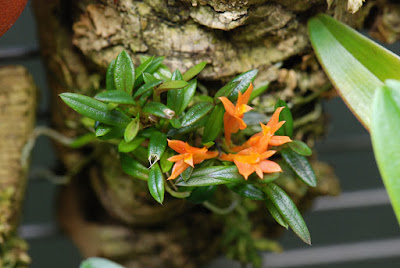Dendrobium subacaule is widespread in a large area. These plants are found in the mountains of New Guinea, on the island of Tidore in the Molukka archipelago, and on the island of Guadalcanal in the Solomon Islands...
Dendrobium subacaule also called as The Almost Stemless Dendrobium, Callista subacaulis, Dendrobium begoniicarpum, Dendrobium delicatulum, Dendrobium junzaingense, Dendrobium oreocharis, Dendrobium tricostatum, Pedilonum begoniicarpum, Pedilonum delicatulum, Pedilonum junzaingense, Pedilonum oreocharis, Pedilonum subacaule, Pedilonum tricostatum, is a species of the genus Dendrobium. This species was described by Caspar Georg Carl Reinwardt ex John Lindley in 1859.
IDENTIFY DENDROBIUM SUBACAULE
Dendrobium subacaule is widespread in a large area. These plants are found in the mountains of New Guinea, on the island of Tidore in the Molukka archipelago, and on the island of Guadalcanal in the Solomon Islands. In Irian Jaya (western New Guinea), they were encountered on the Vogelkop Peninsula, on the Mt.Jaya (Mt.Carstensz) Mountain and on the Cyclop Mountain in the Orion Mountains. In Papua, they meet in the provinces of West Sepik, Enga, Southern Highlands, Western Highlands, Eastern Highlands, Madang, Morobe, Central and Milne Bay. They usually grow at heights of 750-2500 m on small, covered with moss twigs and boughs, but sometimes they are also found in moss covering both rocks and the ground surface.
It is a mini-miniature sized, cool to cold growing epiphyte or occasional lithophyte-terrestrial, which reaching 2-4 cm in height, with reddish brown, 0.5-1.0 cm long pseudobulbs carrying 2 to 3 oval, deciduous, dark green above, purple suffused beneath, 0.5-1.0 cm long leaves.
The Almost Stemless Dendrobium blooms in the spring through fall on leaf less canes with several, short, 2 flowered inflorescence with the flowers facing each other. The flowers are 0.8-1.0 cm in diameter. The petals of both whorls, with slightly jagged edges, can be brick-red or brightly scarlet-red. The lip-shaped, spiky, upwardly directed, is usually yellow or orange, especially at the apex.
DENDROBIUM SUBACAULE CARE AND CULTURE
Cultural information should only be used as a guide, and should be to be adapted to suit you. Your physical location; where you grow your plants, how much time you have to devote to their care, and many other factors, will need to be taken into account. Only then can you decide on the cultural methods that best suit you and your plants.
Light:
Dendrobium subacaule needs a light level of 20000-25000 lux.
Temperature:
The average temperature of the day throughout the year is 25-26 ° C, night 14-15 ° C, giving a daily difference of 10-11 ° C.
Humidity:
For most of the year, The Almost Stemless Dendrobium needs the humidity of70-75%, but at the end of winter and at the beginning of spring it drops to almost 65%.
Substrate, growing media and repotting:
Dendrobium subacaule can be mounted on tree rootstocks or cork, with high humidity ensured and watering is carried out at least once a day in summer. When growing in pots, any loose, quickly drying substrate is recommended. Repotting can be performed when new roots grow.
Watering:
Precipitation is moderate to heavy for most of the year, but there are slightly less during the 3 months of winter. The plants should be kept moist and never completely dried up. During the summer, daily watering is required during hot weather. Additional morning fogging, especially during sunny weather, will certainly have a positive effect on the condition of the plants.
Fertilizer:
It is recommended to apply weekly or every two weeks 1/4-1/2 doses of balanced fertilizer to orchids throughout the year.
Rest period:
In winter, watering should be slightly reduced, especially for Dendrobium subacaule grown in dark and short days at moderate latitudes, but they can never dry up completely. Fertilization should be reduced or eliminated until spring.















COMMENTS